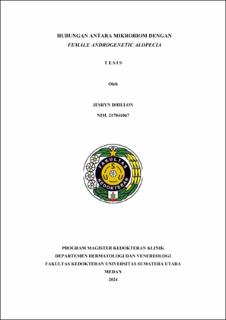Hubungan Antara Mikrobiom dengan Female Androgenetic Alopecia
The Relationship between Microbiome and Female Androgenetic Alopecia

Date
2024Author
Dhillon, Jesryn
Advisor(s)
Putra, Imam Budi
Jusuf, Nelva Karmila
Metadata
Show full item recordAbstract
Background: Hair is an important part of a woman's identity, with hair loss
affecting up to 50% of women throughout their lives. Female androgenetic
alopecia (FAGA) is one of the causes of nonscarring alopecia, and its prevalence
varies across populations. The pathogenesis of FAGA involves genes, hormones,
and microinflammation in hair follicles, with scalp microbiome as a key factor.
Research on the role of the microbiome (aerobic and anaerobic bacteria) in FAGA
is still limited.
Objective: To determine the relationship between microbiome (aerobic and
anaerobic bacteria) and female androgenetic alopecia.
Subjects and Methods: This observational study with a cross-sectional design
involving 30 FAGA subjects and 30 nonFAGA subjects who met the inclusion
and exclusion criteria. Each patient underwent anamnesis, dermatological
examination, and scalp swab collection. The data were statistically analyzed using
the Kruskal-Wallis test and were considered significant with a p-value of <0.05.
Results: In the FAGA group, the most prevalent age group is 36-45 years
(43.3%). The most common severity of FAGA observed is Ludwig I (66.7%). The
most prevalent microbiome (aerobic bacteria) is Staphylococcus, both in the
FAGA group (60%) and the non-FAGA group (30%). The most prevalent
microbiome (anaerobic bacteria) is Cutibacterium, both in the FAGA group
(53.3%) and the nonFAGA group (80%). The results of this study indicate a
correlation between the microbiome (aerobic and anaerobic bacteria) and FAGA
(p=0.028 and 0.024).
Conclusion: There is a relationship between microbiome (aerobic and anaerobic
bacteria) and FAGA.
